The MST Reader is a series of overviews of interesting and timely topics that affect our world.
The MST Reader: A Field Guide to Batteries
With so much of our world running on cell phones, laptops and smart devices, we live in an age that is increasingly battery-powered. Yet, that’s how the electric age began — long before the power grid was built up, electric devices ran on batteries.
It’s a technology that’s more than 200 years old, but the fundamental principles haven’t changed: a battery is a device in which a chemical reaction generates electric charge, the world of chemistry pouring over into the world of physics. While our devices hunger for ever more power, battery science is hemmed in by the periodic table. The battery types we use today have been around for decades — sometimes more than a century — and the improvements in their efficiency and management tend to be incremental.
We use them every day, so let’s get to know them!
Alkaline
Zinc and Manganese Dioxide
Non-rechargeable
Cell voltage: 1.5 V
Common uses: You name it!
While batteries using an alkaline (rather than acidic) electrolyte date back to Thomas Edison in 1901, the modern “dry cell” using zinc and manganese dioxide was invented by the Canadian Lewis Urry in the 1950s. He went on to work for Eveready, and this new type of battery with a stable, un-spillable, paste-type electrolyte became ubiquitous.
From transistor radios and flashlights to television remotes and smoke detectors, alkaline batteries have powered portable devices for decades. If you’re using a non-rechargeable AA, AAA or rectangular 9-volt battery, it’s probably a disposable alkaline battery. (The rest of the batteries in this list are rechargeable.)
10 billion alkaline batteries are made each year worldwide.
Lead-acid
Cell voltage: 2.1 V
Uses: cars, boats, backup power supplies
Invented in 1859, the lead-acid battery is the oldest kind of rechargeable battery, and it is still a vital part of our world. Inexpensive and heavy, their ability to provide a large amount of current reliably has made them staples in cars and boats. That’s the big block of battery in almost every gas-powered car that we use to start the engine, or that we fuss over on a cold day when it hasn’t charged properly and our engine won’t start. When everything’s working right, once the car is running the alternator recharges the battery so it’s ready for the next start.
Most lead-acid batteries are classic “wet cell” batteries, in that the anode and cathode sit in a bath of fluid electrolyte — in this case, lead bathed in sulfuric acid. Tip it over or crack it open and acid pours out. Some high-end modern variants use a gel for the electrolyte, making the battery more resistant to spillage.
Nickel-cadmium (NiCd)
Cell voltage: 1.2 V
Uses: radio-control devices, power tools, portables
Much smaller, lighter and easier to handle than lead-acid batteries, NiCd batteries were the standard for portable rechargeable batteries for decades. They were often manufactured in the same form factors as mass-produced alkaline batteries. Unlike a disposable alkaline battery, they go dead quickly while not in use.
Nickel metal hydride (NiMH)
Cell voltage: 1.2 V
Uses: standard AA, AAA uses
The successor to the rechargeable NiCd battery is the nickel metal hydride battery. It’s a similar chemistry, but with a different chemical composition of the negative electrode, resulting in the ability to store more electricity than NiCd batteries. Nickel metal hydride batteries also have a much lower self-discharge rate, which means they have a longer shelf life; where NiCds that have sat for a while are frustratingly empty, modern NiMH rechargeable batteries still hold ~80% of their charge even after sitting for a year. This makes them a better rechargeable option for slow-drain devices like television remotes.
If you buy rechargeable batteries today that are in a AA or AAA form factor, they are probably NiMH batteries.
Lithium ion/lithium polymer
Cell voltage: 3.6 V
Uses: Behold, our modern world! cell phones, laptops, tablets, electric cars
The lithium-ion rechargeable battery is the new kid on the block, first prototyped in 1985. It holds a lot of energy, it can be recharged many times, and it holds a charge for a long time. As such, it has become the go-to battery for 21st-century devices such as cell phones, laptops, and tablets.
Lithium-ion batteries were expensive in the beginning, but the price has come down dramatically since the early 2000s, with innovation being driven by demand. Tesla powers its cars on lithium-ion batteries, and they’ve turned their sights on improving the technology and bringing down battery costs. There are more than seven thousand lithium-ion cells in a single Tesla Model S.
Further viewing
“How Batteries Work” on YouTube:
